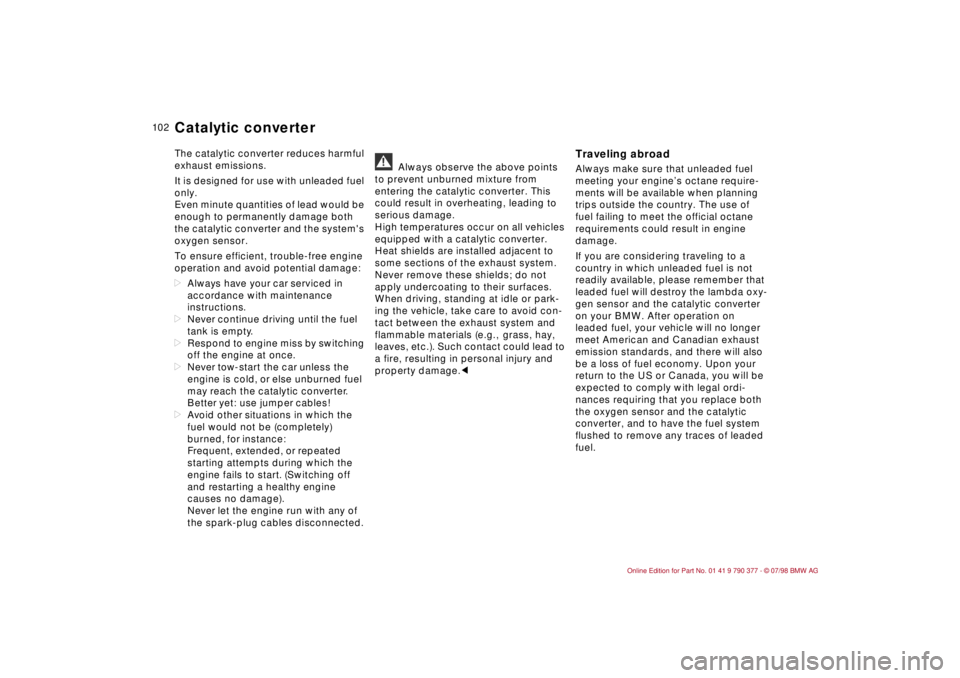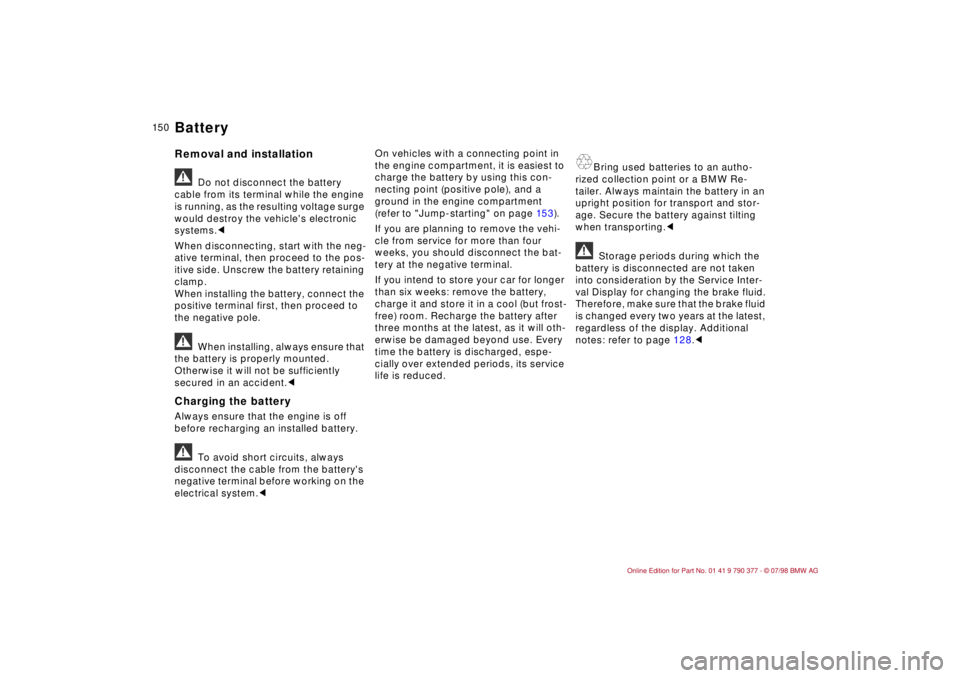1998 BMW CONVERTIBLE jump cable
[x] Cancel search: jump cablePage 103 of 179

10 2
The catalytic converter reduces harmful
exhaust emissions.
It is designed for use with unleaded fuel
only.
Even minute quantities of lead would be
enough to permanently damage both
the catalytic converter and the system's
oxygen sensor.
To ensure efficient, trouble-free engine
operation and avoid potential damage:
dAlways have your car serviced in
accordance with maintenance
instructions.
dNever continue driving until the fuel
tank is empty.
dRespond to engine miss by switching
off the engine at once.
dNever tow-start the car unless the
engine is cold, or else unburned fuel
may reach the catalytic converter.
Better yet: use jumper cables!
dAvoid other situations in which the
fuel would not be (completely)
burned, for instance:
Frequent, extended, or repeated
starting attempts during which the
engine fails to start. (Switching off
and restarting a healthy engine
causes no damage).
Never let the engine run with any of
the spark-plug cables disconnected.
a
Always observe the above points
to prevent unburned mixture from
entering the catalytic converter. This
could result in overheating, leading to
serious damage.
High temperatures occur on all vehicles
equipped with a catalytic converter.
Heat shields are installed adjacent to
some sections of the exhaust system.
Never remove these shields; do not
apply undercoating to their surfaces.
When driving, standing at idle or park-
ing the vehicle, take care to avoid con-
tact between the exhaust system and
flammable materials (e.g., grass, hay,
leaves, etc.). Such contact could lead to
a fire, resulting in personal injury and
property damage.c
Traveling abroadAlways make sure that unleaded fuel
meeting your engineÕs octane require-
ments will be available when planning
trips outside the country. The use of
fuel failing to meet the official octane
requirements could result in engine
damage.
If you are considering traveling to a
country in which unleaded fuel is not
readily available, please remember that
leaded fuel will destroy the lambda oxy-
gen sensor and the catalytic converter
on your BMW. After operation on
leaded fuel, your vehicle will no longer
meet American and Canadian exhaust
emission standards, and there will also
be a loss of fuel economy. Upon your
return to the US or Canada, you will be
expected to comply with legal ordi-
nances requiring that you replace both
the oxygen sensor and the catalytic
converter, and to have the fuel system
flushed to remove any traces of leaded
fuel.
Catalytic converter
Page 150 of 179

14 9
At a glanceControlsCar careRepairsTechnicalDataIndex
The battery is located behind the right-
side trim panel in the luggage compart-
ment. A separate positive terminal in
the engine compartment is available for
jump-starting (also refer to page 153).
Only certain battery types may be used
on the BMW convertible. Consult your
BMW Retailer for details.
The battery is maintenance-free, mean-
ing that the electrolyte will normally last
for the life of the battery.
Should the electrolyte drop to below
the minimum level - e.g., during extend-
ed operation in hot climates - add dis-
tilled water (no acid!).
Electrolyte level: Up to the "MAX" mark
on the outside of the battery in each
cell, approx. 0.2 inches (5 mm) above
the top of the plates.
Keep the top of the battery clean and
dry.
SymbolsYou will find the following symbols on
your car battery. To avoid injury, please
observe the corresponding precautions
whenever you work with or near the
battery.
360de125
Before working with the battery,
read the following:
R
Wear eye protection. Avoid let-
ting acid or lead particles come
into contact with your eyes, your
skin or your clothing.
S
Battery acid is extremely corro-
sive. Wear eye protection and
protective gloves. Do not tilt the
battery; acid could emerge from the
ventilation openings.
T
Ensure that children keep well
away from batteries and battery
acid.
U
Never allow sparks or open
ßame, and do not smoke in the
vicinity of the battery. Avoid
sparks from electrical cables and
equipment. Never short-circuit the bat-
tery terminals. There is a danger of
injury from powerful sparks.
V
A highly-explosive gas is gener-
ated when the battery is
charged.
W
If you happen to get acid in your
eyes, rinse thoroughly for sev-
eral minutes with clear water.
Then consult a physician immediately. If
you get acid spray on your skin or cloth-
ing, apply soap immediately to neutral-
ize the acid, then rinse with plenty of
water. If electrolyte is accidentally
ingested, consult a physician immedi-
ately.
X
To protect the casing against
ultraviolet radiation, avoid
exposing it to direct sunlight.
A discharged battery can freeze; always
store the battery in areas where the
temperature remains above freezing.
Battery
Page 151 of 179

15 0
Removal and installationa
Do not disconnect the battery
cable from its terminal while the engine
is running, as the resulting voltage surge
would destroy the vehicle's electronic
systems.c
When disconnecting, start with the neg-
ative terminal, then proceed to the pos-
itive side. Unscrew the battery retaining
clamp.
When installing the battery, connect the
positive terminal first, then proceed to
the negative pole.
a
When installing, always ensure that
the battery is properly mounted.
Otherwise it will not be sufficiently
secured in an accident.c
Charging the battery Always ensure that the engine is off
before recharging an installed battery. a
To avoid short circuits, always
disconnect the cable from the battery's
negative terminal before working on the
electrical system.cOn vehicles with a connecting point in
the engine compartment, it is easiest to
charge the battery by using this con-
necting point (positive pole), and a
ground in the engine compartment
(refer to "Jump-starting" on page 15 3).
If you are planning to remove the vehi-
cle from service for more than four
weeks, you should disconnect the bat-
tery at the negative terminal.
If you intend to store your car for longer
than six weeks: remove the battery,
charge it and store it in a cool (but frost-
free) room. Recharge the battery after
three months at the latest, as it will oth-
erwise be damaged beyond use. Every
time the battery is discharged, espe-
cially over extended periods, its service
life is reduced.
A
Bring used batteries to an autho-
rized collection point or a BMW Re-
tailer. Always maintain the battery in an
upright position for transport and stor-
age. Secure the battery against tilting
when transporting.c
a
Storage periods during which the
battery is disconnected are not taken
into consideration by the Service Inter-
val Display for changing the brake fluid.
Therefore, make sure that the brake fluid
is changed every two years at the latest,
regardless of the display. Additional
notes: refer to page 128.c
Battery
Page 154 of 179

15 3
At a glanceControlsCar careRepairsTechnicalDataIndex
Never use spray starter fluids to start
the engine.
When the battery is discharged, you
can use two jumper cables to start your
car with power from the battery in a
second vehicle. Always use jumper
cables with fully insulated handles on
the terminal clamps.a
When the engine is running, con-
tact with electrical conductors and com-
ponents is dangerous and can be fatal.c
Carefully observe the following instruc-
tions to avoid personal injury as well as
damage to one or both vehicles:
1 Ensure that the battery on the sup-
port vehicle is also rated at 12 volts,
and that the capacity (Ah) is roughly
comparable (printed on casing).
2 Leave your battery connected to the
car's electrical system.
3 The bodies of the two vehicles must
not touch, or a short circuit could
result.4 Start by connecting the positive ter-
minal of both batteries with a jumper
cable. If the battery of the BMW is not
installed in the engine compartment,
a supplementary positive terminal is
provided in the engine compartment
(the cover is marked "+", remove by
pulling tab, see arrow 1 in illustration).
Then connect up the batteries' nega-
tive poles. Attach the cable to either
the support vehicle's negative battery
terminal, or to a suitable ground on its
engine or bodywork. On the BMW
there is a special nut, refer to arrow 2;
the nut might also be located further
forward, on the suspension strut
dome.
a
Observe the same sequence for
connecting the jumper cables when
helping other vehicles; this will help pre-
vent sparks from being generated at the
battery.c
5 If the battery on the support vehicle is
weak, start the engine and let it run.
Start the engine on the vehicle need-
ing the jump-start, and allow it to run
as usual. If necessary repeat the
attempt to start after a few minutes;
this allows for current intake by the
discharged battery.
Before disconnecting the jumper
cables from your BMW, turn on the
lamps, rear window defroster and
highest blower speed to prevent a
voltage surge at the voltage regulator.
Then disconnect the jumper cables in
reverse sequence.
Depending on the cause of the fault,
recharge the battery.
12
360de105
Jump-starting